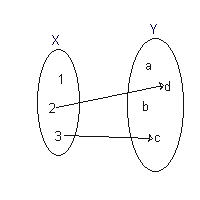Sem resumo de edição |
Sem resumo de edição |
(Sem diferença)
| |
Edição das 20h42min de 9 de setembro de 2003
de:Funktion (Mathematik) eo:Funkcio en:Function fr:fonction nl:Functie (wiskunde) pl:Funkcja matematyczna
A palavra "função" tem vários significados em várias áreas:
- Em sociologia, funções sociais são a base do functionalism.
- Em ciência da computação, uma função é um subprograma ou subrotina. Veja também em Programação funcional.
- Esta págian versa sobre funções matemáticas (a seguir).
Introdução
O conceito de uma função é uma generalização de uma noção comum de uma "fórmula matemática". Funções descrevem relações matemáticas especiais entre dois objetos, x e y=f(x). O objeto x é chamado o argumento da função f e o objeto y depende de x.
Intuitively, a function is a way to assign to each value of the argument x a unique value of the function f(x). This could be specified by a formula, a relationship, and/or a rule. This concept is deterministic, always producing the same result from the same input (the generalization to random values is called a stochastic process). Uma função pode ser vista como uma "máquina" ou "caixa preta" que converte entradas válidas em saídas de forma unívoca.
The most familiar kind of function is that where the argument and the function's value are both numbers, and the functional relationship is expressed by a formula, and the value of the function is obtained from the arguments by direct substitution. Consider for example
which assigns to any number x its square.
A straightforward generalization is to allow functions depending not on a single number, but on several. For instance,
which takes two numbers x and y and assigns to them their product, xy.
According to how a function is specified, it is said to be an explicit function (as above) or an implicit function, as in
which implicitly specifies the function
See also How to specify a function.
We have seen that the intuitive notion of function is not limited to computations using single numbers, but the mathematical notion of function is not limited to computations, or even to situations involving numbers at all. Because of this generality, functions appear in a wide variety of mathematical contexts, and several mathematical fields are based on the study of functions.
It should be noted that the words "function", "mapping", "map" and "transformation" are usually used synonymously. Furthermore, functions may occasionally referred to as well-defined function or total function (See the section "Formal Definition" below).
História
As a mathematical term, "function" was coined by Leibniz in 1694, to describe a quantity related to a curve; such as a curve's slope or a specific point of said curve. Functions related to curves are nowaday called differentiable functions and are still the most frequently type of functions encounted by non-mathematicians. For such kind of functions, one can talk about limits and derivatives; both are measurements of the change of output values associated to a change of input values, and they are the basics of calculus.
The word function was later used by Euler during the mid-18th Century to describe an expression involving various arguments; ie: y = F(x). By broadening the definition of functions, mathematicians were then able to study "strange" mathematical objects such as functions which are nowhere differentiable. Those functions, first thought as purely imaginary and called collectively "monsters" as late as the turn of the 20th century, were later found to be important in the modelling of physical phenomena such as Brownian motion.
During the 19th Century, mathematicians started to formalize all the different branches of mathematics. Weierstrass advocated building calculus on arithmetic rather than on geometry, which favoured Euler's definition over Leibniz's (see arithmetization of analysis). Towards the end of the century, mathematicians started trying to formalize all of mathematics using set theory and they sought definitions of every mathematical object as a set. It was Dirichlet that gave the modern "formal" definition of function.
In Dirichlet's definition, a function is a special case of a relation, which is a set. In most cases of practical interest, however, the differences between the modern definition and Euler's definition is negligible.
Definição Formal
Formally, a function f from a set X of input values to a set Y of possibly output values (written as f: X → Y) is a relation between X and Y which satisfies:
- f is functional: if x f y (x is f-related to y) and x f z, then y = z. i.e., for each input value, there should only be one possible output value.
- f is total: for all x in X, there exists a y in Y such that x f y. i.e. for each input value, the formula should produce at least one output value within Y.
For each input value x in the domain, the corresponding unique output value y in the codomain is denoted by f(x).
Consider the following three examples:
| Arquivo:NotMap1.png | This is not a "well-defined" function; because, the element 3, in X, is associated with two elements b and c in Y (Condition 1 is violated). This is a multivalued function. |
 | This is not a "well-defined" function; because, the element 1, in X , is associated with nothing (Condition 2 is violated). This is a partial function. |
| Arquivo:Mathmap.png | This is a function, called a discrete function (or rarely piecewise function); of which the range is {a,c,d}. It can be stated explicitly as
|
Occasionally, all three relations above are called functions. In this case, the function satisfies Conditions (1) and (2) is said to be a "well-defined function" or "total function". In this encyclopedia, the terms "well-defined function", "total function" and "function" are synonymous.
Domínios, Contra-domínios e Imagens
X, the set of input values, is called the domain of f and Y, the set of possible output values, is called the codomain. The range of f is the set of all actual outputs {f(x) : x in the domain}. Beware that sometimes the codomain is wrongly called the range because of a failure to distinguish between possible and actual values.
In computer science, specifying the datatypes of the arguments and return values sets the domain and codomain (respectively) of a subprogram. So the domain and codomain are constraints imposed initially on a function; on the other hand the range has to do with how things turn out in practice.
Gráfico de uma Função
The graph of a function f is the collection of all points(x, f(x)), for all x in set X. In the example of the discrete function, the graph of f is {(1,a),(2,d),(3,c)}. There are theorems formulated or proved most easily in terms of the graph, such as the closed graph theorem.
If X and Y are real lines, then this definition coincides with the familiar sense of graph. Below is the graph of a cubic function, which is a curve:
[[Image::cubicpoly.png]]
Note that since a relation on the two sets X and Y is usually formalized as a subset of X×Y, the formal definition of function actually identifies the function f with its graph.
Imagens and preimages
The image of an element x∈X under f is the output f(x).
The image (or direct image) of A⊂X under f is the subset of Y defined by
- f(A) := {f(x) : x in A}.
Notice that the range of f is the image f(X) of its domain. In our example of discrete function, the image of {2,3} under f is f({2,3})={c,d} and the range of f is {a,c,d}.
The preimage of y∈Y is the set f−1(y)={x∈X : f(x)=y}. If the set is a singleton {x}, then we simply say that x=f−1(y) is the preimage of y.
The preimage (or inverse image) of B ⊂ Y under f is the subset of X defined by
- f −1(B) := {x in X : f(x)∈B}.
In our example of discrete function, the preimage of {a,b} is f −1({a,b})={1}.
Note that with this definiton, f -1 becomes a function whose domain is the set of all subsets of Y (also known as the power set of Y) and whose codomain is the power set of X'.
Some consequences that follow immediately from these definitions are:
- f(A1 ∪ A2) = f(A1) ∪ f(A2).
- f(A1 ∩ A2) ⊆ f(A1) ∩ f(A2).
- f −1(B1 ∪ B2) = f −1(B1) ∪ f −1(B2).
- f −1(B1 ∩ B2) = f −1(B1) ∩ f −1(B2).
- f(f −1(B)) ⊆ B.
- f −1(f(A)) ⊇ A.
The results relating images and preimages to the algebra of intersection and union work for any number of sets, not just for 2.
Funções Injectores, Sobrejetoras e Bijetoras
Several types of functions are very useful, deserve special names:
- injective (one-to-one) functions send different arguments to different values; in other words, if x and y are members of the domain of f, then f(x) = f(y) if and only if x = y. Our example is an injective function.
- surjective (onto) functions have their range equal to their codomain; in other words, if y is any member of the codomain of f, then there exists at least one x such that f(x) = y.
- bijective functions are both injective and surjective; they are often used to show that the sets X and Y are "the same" in some sense.
Exemplos de Funções
(More can be found at List of functions.)
- The relation wght between persons in the United States and their weights.
- The relation between nations and their capitals.
- The relation sqr between natural numbers n and their squares n2.
- The relation nlog between positive real numbers x and their natural logarithms ln(x). Note that the relation between real numbers and their natural logarithms is not a function because not every real number has a natural logarithm; that is, this relation is not total and is therefore only a partial function.
- The relation dist between points in the plane R2 and their distances from the origin (0,0).
- The relation grav between a point in the punctured plane R2 \ {(0,0)} and the vector describing the gravitational force that a certain mass at that point would experience from a certain other mass at the origin (0,0).
Most commonly used types of mathematical functions involving addition, division, exponents, logarithms, multiplication, polynomials, radicals, rationals, subtraction, and trigonometric expressions. They are sometimes collectively referred as Elementary functions -- but the meaning of this term varies among different branches of mathematics. Example of non-elementary functions are Bessel functions and gamma functions.
n-ary function: function of several variables
Functions in applications are often functions of several variables: the values they take depend on a number of different factors. From a mathematical point of view all the variables must be made explicit in order to have a functional relationship - no 'hidden' factors are allowed. Then, again from the mathematical point of view, there is no qualitative difference between functions of one and of several variables. A function of three real variables is just a function that applies to triples of real numbers. The following paragraph says this in more formal language.
If the domain of a function is a subset of the Cartesian product of n sets then the function is called an n-ary function. For example, the relation dist has the domain R × R and is therefore a binary function. In that case dist((x,y)) is simply written as dist(x,y).
Another name applied to some types of functions of several variables is operation. In abstract algebra, operators such as "*" are defined as binary functions; when we write a formula such as x*y in this context, we are implicitly invoking the function *(x,y), but writing it in a convenient infix notation.
An important theoretical paradigm, functional programming, takes the function concept as central. In that setting, the handling of functions of several variables becomes an operational matter, for which the lambda calculus provides the basic syntax. The composition of functions (see under composing functions immediately below) becomes a question of explicit forms of substitution, as used in the substitution rule of calculus. In particular, a formalism called currying can be used to reduce n-ary functions to functions of a single variable.
Funções Compostas
The functions f: X → Y and g: Y → Z can be composed by first applying f to an argument x and then applying g to the result. Thus one obtains a function g o f: X → Z defined by (g o f)(x) := g(f(x)) for all x in X. As an example, suppose that an airplane's height at time t is given by the function h(t) and that the oxygen concentration at height x is given by the function c(x). Then (c o h)(t) describes the oxygen concentration around the plane at time t.
If Y⊂X then f may compose with itself; this is sometimes denoted f 2. (Do not confuse it with the notation commonly seen in trigonometry.) The functional powers f of n = f n o f = f n+1 for natural n follow immediately. On their heels comes the idea of functional root; given f and n, find a g such that gn=f. (Feynman illustrated practical use of functional roots in one of his anecdotal books. <which?> Tasked with building an analogue arctan computer and finding its parts overstressed, he instead designed a machine for a functional root <fifth?> of arctan and chained enough copies to make the arctan machine.)
Função inversa
If a function f:X→Y is bijective then preimages of any element y in the codomain Y is a singleton. A function taking y∈Y to its preimage f−1(y) is a well-defined function called the inverse of f and is denoted by f−1.
An example of an inverse function, for f(x) = x2, is f(x)−1 = √x. Likewise, the inverse of 2x is x/2. The inverse function is the function that "undoes" its original.
Pointwise operations
If f: X → R and g: X → R are functions with common domain X and codomain is a ring R, then one can define the sum function f + g: X → R and the product function f × g: X → R as follows:
- (f + g)(x) := f(x) + g(x);
- (f × g)(x) := f(x) × g(x);
for all x in X.
This turns the set of all such functions into a ring. The binary operations in that ring have as domain ordered pairs of functions, and as codomain functions. This is an example of climbing up in abstraction, to functions of more complex types.
By taking some other algebraic structure A in the place of R, we can turn the set of all functions from X to A into an algebraic structure of the same type in an analogous way.
Enumeration
The number of computable functions (aka calculable functions) from integers to integers is countable and its size is the transfinite number aleph-null, which is written . The number of all functions from integers to integers is higher: the same as the cardinality of the real numbers. This counting argument shows that there are functions from integers to integers that are not computable. For examples of noncomputable functions, see the articles on the halting problem and Rice's theorem.










 " class="attachment-atbs-s-4_3 size-atbs-s-4_3 wp-post-image" alt="O que estudar para o enem 2023">
" class="attachment-atbs-s-4_3 size-atbs-s-4_3 wp-post-image" alt="O que estudar para o enem 2023"> " class="attachment-atbs-s-4_3 size-atbs-s-4_3 wp-post-image" alt="Qual melhor curso para fazer em 2023">
" class="attachment-atbs-s-4_3 size-atbs-s-4_3 wp-post-image" alt="Qual melhor curso para fazer em 2023"> " class="attachment-atbs-s-4_3 size-atbs-s-4_3 wp-post-image" alt="Enem: Conteúdos E Aulas On-Line São Opção Para Os Estudantes">
" class="attachment-atbs-s-4_3 size-atbs-s-4_3 wp-post-image" alt="Enem: Conteúdos E Aulas On-Line São Opção Para Os Estudantes"> " class="attachment-atbs-s-4_3 size-atbs-s-4_3 wp-post-image" alt="Como Fazer Uma Carta De Apresentação">
" class="attachment-atbs-s-4_3 size-atbs-s-4_3 wp-post-image" alt="Como Fazer Uma Carta De Apresentação"> " class="attachment-atbs-s-4_3 size-atbs-s-4_3 wp-post-image" alt="Como Escrever Uma Boa Redação">
" class="attachment-atbs-s-4_3 size-atbs-s-4_3 wp-post-image" alt="Como Escrever Uma Boa Redação"> " class="attachment-atbs-s-4_3 size-atbs-s-4_3 wp-post-image" alt="Concurso INSS edital 2022 publicado">
" class="attachment-atbs-s-4_3 size-atbs-s-4_3 wp-post-image" alt="Concurso INSS edital 2022 publicado">


